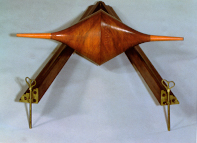
51 x 8 (rhombus) 80.2 (rods)
INDEX 1788 : B.IV.92
Rhombus conicus a me inventus praecedenti similis, qui tamen ad utrumque verticem duos habet junctos veluti cylindros; et binae regulae prioribus similes sed tamen longiores, quas super Rhombus varias egfficit oscilattiones antequam in humiliore situ quiescat.
Conical rhombus, invented by me, like the previous piece, with two cylindrical parts connected to the vertices; and two rods similar to those mentioned, but longer, on top of which the lozenge oscillates several times before coming to rest at the lowest point.
Wood and brass
This apparatus was intended for the study of the centre of gravity. It consists of: 1) a wooden piece in the shape of a double cone with a common base with the ends cut off and substituted by cylindrical extensions; 2) two wooden rods linked in a V shape by a hinge at one end and with a brass regulating screw at the other end of each. They are placed on a flat table, with the vertex resting on the surface and their sides forming an inclined plane, the slope of which is regulated by the screws.
Experiments using this equipment consist of placing the double cone near the vertex, then letting it go. The double cone will begin to move up the slope, then oscilate and finally reach equilibrium at a position between the vertex and the ends of the rods.
This surprising result seems to violate the laws of gravity. However, what is really happening is that the horizontal axis through the centre of gravity is going down as it moves away from the vertex. In fact, when the double cone is placed near the vertex of the rods its longitudinal axle is at a higher level than when it is in the position of equilibrium.
In the collection of the Physics Museum there is another double cone, differing from the one displayed here only in that the ends are not cut off.
From Colégio dos Nobres, catalogue n.º 85.
Desaguliers, Jean-Théophile, A Course of Experimental Philosophy, London, 1734. Vol.I, p.55, Pl. IV, Fig.14.